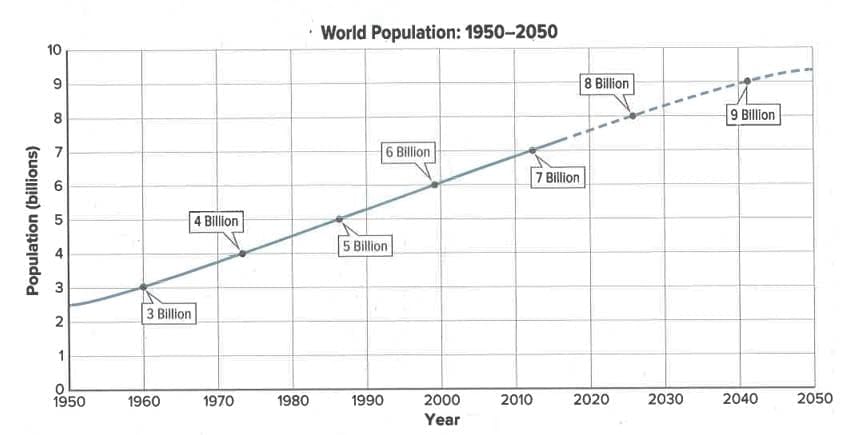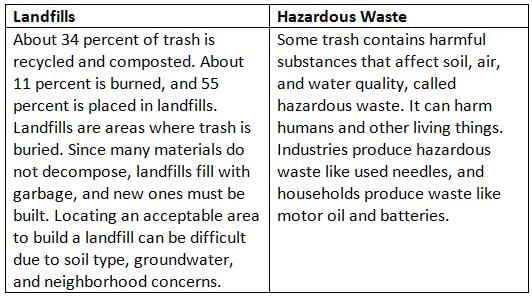- Runoff carrying chemicals from landfills, mines, and agricultural fields can pollute both soil and water.
- Pollution refers to the contamination of the environment with harmful substances.
- These pollutants can lower the quality of natural resources like soil and water.
- Pollution can have severe effects on many plant and animal species, often threatening their survival.
Impact on Land Chapter Notes | Science for Grade 6 PDF Download
| Table of contents |

|
| Introduction |

|
| How does a growing population impact earth? |

|
| What are the consequences of using land as a resource? |

|
| What actions help protect the land? |

|
Introduction
The "Impact on Land" chapter teaches us how human activities affect Earth's land and what we can do to protect it. As the human population grows, we use more land for homes, farming, and other needs, which can harm the environment. This chapter explores how actions like deforestation, farming, urbanization, and waste disposal change the land and its ecosystems. It also explains how we can reduce these impacts through conservation, recycling, and careful land management to keep Earth healthy for all living things.
How does a growing population impact earth?

- About 1,000 years ago, there were around 300 million people on Earth.
- Today, there are over 7 billion people, and by 2050, there could be more than 9 billion.
- More people mean we need more natural resources like food, water, and shelter.
- Natural resources are things from Earth that living things use to survive.
- Growing populations need more houses, roads, and farmland, which uses land as a resource.
- Using more land can harm the environment and affect plants, animals, and ecosystems.
Land as a Resource
- All living things, including people, depend on land for living space.
- Living space includes both natural habitats and human-made areas like buildings, streets, sidewalks, and parking lots.
- Soil is used to grow crops for food production.
- Forests are harvested to provide wood for furniture, houses, and paper products.
- People also mine minerals from the land, sometimes going as far as removing entire mountaintops to access resources.
- In all these ways, land is used to meet human needs and support life.
What are the consequences of using land as a resource?
Deforestation
- Deforestation is when large areas of forests are cut down for farming, grazing, or building.
- It destroys animal habitats, which can lead to species becoming endangered or extinct.
Impact of Deforestation
- Cutting forests reduces animal habitats, harming biodiversity.
- Tropical rainforests are complex ecosystems that are hard to replace.
- Deforestation increases carbon dioxide in the atmosphere, affecting the climate.
- Clearing land for farming or building also impacts the land's ability to support life.
- Tropical rainforests, which house 50% of Earth's species, take hundreds of years to regrow.
- Trees take carbon dioxide from the air during photosynthesis, so cutting them increases carbon dioxide in the atmosphere.
- More carbon dioxide can affect the climate and environment.
Land Usage for Agriculture
- As the population grows, we need more food, which means using more land for farming.
- Farming can harm the land through pesticide use, soil erosion, and space demands.
Impacts of Agriculture
Pesticide Usage:
- Farmers use high-yielding seeds and chemical fertilizers to grow more food.
- Herbicides and pesticides kill weeds and pests but can pollute groundwater.
- Runoff from fertilizers can harm rivers, streams, and aquatic life.
Soil Quality:
- Removing plants for farming exposes soil, which can be washed away by water or wind.
- Soil erosion can lead to desertification, where land becomes like a desert and can't grow crops.
- Desertification makes it hard to produce enough food for people.
Space:
- About one-fifth of U.S. land is used for growing crops, and one-fourth is for grazing livestock.
- In Texas, 65% of land is used for grazing cattle.
- Some land grows crops like corn and hay to feed livestock.
Did You Know?
Changes in biodiversity impact more than just a single species—everything in nature is connected. When one organism disappears or is affected, it can cause a chain reaction. For example, if bees decline due to environmental changes, plants suffer because they aren’t being pollinated. This leads to fewer crops and lower yields, which means less food is available to feed people around the world.
Urbanization
- Urbanization is when rural land is turned into suburbs or city areas for homes and buildings.
- Paving land for roads and buildings stops water from soaking into the soil.
- More water flows into streams, increasing stream discharge and flood risks.
- Urbanization destroys habitats, reduces farmland, and affects groundwater supplies.
- Wetlands are drained for development, causing issues like rising sea levels and coastal erosion.
Impact of Urbanization
- Paved areas increase water runoff, leading to more flooding.
- Urbanization reduces groundwater because water can't soak into the soil.
- It destroys habitats and farmland, affecting plants and animals.
- Draining wetlands harms ecosystems and increases problems like erosion.
Urbanization can change the relative effects of top-down and bottom-up factors
- Urbanization breaks up habitats and introduces new species.
- In rural areas like the Sonoran Desert, plant growth is limited by water (bottom-up system).
- In cities like Phoenix, watering increases plant growth, supporting more herbivores and predators (top-down system).
- More plants in cities lead to more insects and birds, changing how species interact.
- These changes affect services like pollination and pest control in urban areas.
Landfills and Hazardous Waste
- About 60% of trash goes to landfills, where it is buried.
- Only 34% of trash is recycled or composted, and 11% is burned.
- Landfills fill up quickly because many materials don't decompose or break down slowly.
- Finding new landfill sites is hard due to soil type, groundwater, and community concerns.
- Hazardous waste, like medical needles or batteries, can harm soil, air, and water.

Pollution
Resource Use
- Resources like wood, petroleum, and metals are used for everyday products.
- Using resources carelessly can harm the environment.
- Conservation means using Earth's materials carefully to avoid damage.
- Conservation helps prevent shortages of important materials.
Reduce, Reuse, Recycle
- Developed countries use more resources than others.
- Reducing means using less of a material to begin with.
- Reusing means finding new uses for items instead of throwing them away.
- Recycling means turning materials like glass, paper, or plastic into new products.
- Composting yard waste and vegetable scraps makes fertilizer for gardens.
- These actions help save land resources and reduce environmental harm.
Managing Land Resources
- Managing land resources is challenging because some uses involve renewable resources, while others do not.
- The limited amount of land leads to competition for space.
- For example, landfills take up valuable land and can potentially pollute the environment.
- Land managers must balance resource use, environmental protection, and land availability.
- Preserving Ecosystems and Forests:
- Governments can manage forests and ecosystems by preserving land, where logging and development are banned or tightly regulated.
- In protected forests, loggers may selectively cut trees and then plant new trees to replace them.
- This process is called reforestation, which helps maintain tree populations, as trees are renewable resources.
- Managing Mined Land:
- Land that has been mined must be restored based on government regulations.
- Reclamation is the process of reshaping mined land, covering it with soil, and replanting vegetation, such as trees and grasses.
- Sustainable Farming and Grazing:
- Farming land can be managed to reduce soil erosion and increase crop yields.
- Leaving crop stalks on the field after harvest helps protect the soil.
- Organic farming methods that avoid synthetic fertilizers can also help conserve soil health.
|
277 docs|10 tests
|
FAQs on Impact on Land Chapter Notes - Science for Grade 6
| 1. How does a growing population affect the Earth's land resources? |  |
| 2. What are the main consequences of using land as a resource? |  |
| 3. What actions can individuals take to help protect the land? |  |
| 4. How does urbanization impact land use and the environment? |  |
| 5. Why is it important to manage land resources sustainably? |  |



















